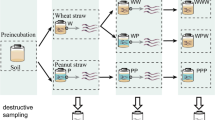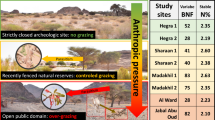Abstract
Leh is a high-altitude district in the union territory of Ladakh. It is situated on the Indus river’s bank and the high elevation of the mountains predominates the surrounding area. Very little information is available about the nematode fauna of these regions. Hence, a survey was conducted and soil samples were collected from agricultural fields of different localities of district Leh (Ladakh) to understand the diversity of soil and plant nematode fauna, to ascertain its current status and to study nematode communities. A total of 27 nematode genera were encountered during the present study. Among them, eleven belong to herbivores, six to bacterivores, four to predaceous, and three each belong to the fungivores and omnivores group. Helicotylenchus sp. was the most prevalent and dominating species in the overall nematode community. The herbivores trophic group was the most prevalent, whereas the bacterivores trophic group was more abundant and prominent in the population. This study showed that a significant variety of nematode fauna remains undiscovered, and it is vital to investigate the variety of beneficial and harmful nematodes in this area.





Similar content being viewed by others
Data availability
All the data generated in the study is made available in the figures and tables in the present manuscript.
References
Ahmad W (1996) Plant parasitic nematodes of India—an identification manual. Department of Zoology, AMU Aligarh press, Aligarh, p 345
Ahmad W, Jairajpuri MS (2010) Mononchida—the predaceous soil nematodes. Nematology monographs and perspectives, vol 7. E. J. Brill, Leiden, p 112
Baermann G (1917) Eine einfache Methode zur Auffinfung von Ankylostomum (Nematoden) Larven in Erdporben. Geneesk Tijdsch. Ned Indie 57:131–137
Bilgrami AL, Pervez R (2000) Numerical analysis of pre feeding and post feeding attraction and aggregation of Discolaimus major and Laimydorus baldus ( Dorylaimida : Nematoda) at feeding site formed with prey nematodes belonging to different trophic groups. Act Zool Taiw 11:83–93
Bongers T, Bongers M (1998) Functional diversity of nematodes. Appl Soil Ecolo 10:239–251
Cobb NA (1918) Estimating the nematode population of soil. Agric. Tech. Cire. Bur. Pl. Ind. U.S. Dep. Agric., No. 1
Goodey T (1963) Soil and freshwater nematodes (Revised by J. B. Goodey). Methuen, London, p 544
Jairajpuri MS, Ahmad W (1992) Dorylaimida: free-living, predaceous and plant-parasitic nematodes. E.J. Brill, Leiden, The Netherlands and Oxford & IBH, New Delhi, p 465
Khan ML, Sharma GC (1992) Seasonal fl uctuations in plant parasitic nematodes in almond, Prunus amygdalus rhizosphere. Indian J Hort Farming 5:10–13
Kouser Y, Shah AA (2021) A comparative diversity analysis of soil nematodes of Rajouri, Jammu and Kashmir, India. Bio Biotech Res Commun 14(4):1687–1700
Mankau R (1980) Biological control of nematode pests by natural enemies. Annu Rev Phytopathol 18:415–440
Norton DC (1978) Ecology of plant parasitic nematodes. Wiley, NewYork, pp 31–58
Pervez R (2006) Population structure of plant parasitic and predatory nematodes associated from Firozabad districts (Uttar Pradesh). Curr Nematol 16(1,2):51–54
Pervez R, Bilgrami AL (2000) Chemosensory responses of predatory nematodes, Mesodorylaimus bastiani and Aquatides thornei towards kairomones emitted by prey nematodes belonging to different trophic groups. Nematol Medit 28:267–277
Pervez R, Rao U (2020a) Diversity and community structure of the plant and soil nematodes associated with Jamun (Syzygium cumini L.) rhizosphere from New Delhi, India. J Ento Zool Stud 8(6):1304–1307
Pervez R, Rao U (2020b) Diversity and community structure of soil nematodes associated with tuberose (Polianthes tuberose L.) from Hapur district (Uttar Pradesh). Ind J Nematol 49(2):193–197
Pervez R, Bilgrami AL, Kondo E, Yoshiga T (2001) Attraction and aggregation behavior of Mesodorylaimus bastiani and Aquatides thornei (Nematoda: Dorylaimida). Appl Ento Zool 36(2):243–249
Procter DI (1990) Global overview of the functional roles of soil-living nematodes in terrestrial communities and ecosystems. J Nematol 22(1):1–7
Seinhorst JW (1959) A rapid method for the transfer of nematodes from fixative to anhydrous glycerin. Nematologica 4:67–69
Sharma GC, Kashyap AS (2009) Effect of different intercrops on the nematode populations and yield of apricot var. New Castle Ind J Horti 66:420–421
Siddiqi MR (2000) Tylenchida-parasites of plants and insects, 2nd edn. CABI Publishing, London, p 852
Sivakumar M, Poornima K, Mani MP, Umamaheshwari R (2002) Biodiversity of nematode fauna in Tamil Nadu range of Nilgiris biosphere. Ind J Nematol 32(2):139–142
Waliullah MIS, Kaul V (1997) Nematodes associated with cherry plants in Kashmir valley. Ind J Nematol 27:237
Yeates GW (2003) Nematodes as soil indicators: functional and biodiversity aspects. Biol Fert Soil 37(4):199–210. https://doi.org/10.1007/s00374-0030586-5
Yeates GW, Bongers T, Degoede RGM, Freckman DW, Georgieva SS (1993) Feeding habits in soil nematode families and genera—an outline for soil ecologists. J Nematol 25:315–331
Yeates GW, Bongers T (1999) Nematode diversity in agro ecosystems. Invertebrate biodiversity as bioindicators of sustainable landscapes, p 113–135
Acknowledgements
The Director and Joint Director (Research), ICAR- Indian Agricultural Research Institute, New Delhi, are thanked by the authors for providing all the necessary facilities for this study. We also acknowledge Dr. M. A. Khan, Principal Scientist, Division of Soil Science and Ag. chemicals, ICAR-IARI, New Delhi for help in soil characterization.
Author information
Authors and Affiliations
Corresponding author
Ethics declarations
Conflict of interest
The authors declare that they have no conflict of interest. The study presented in the manuscript does not involve human or animal subjects. All authors have reviewed the final version of the manuscript and agree to its submission to your journal.
Additional information
Publisher's Note
Springer Nature remains neutral with regard to jurisdictional claims in published maps and institutional affiliations.
Rights and permissions
Springer Nature or its licensor (e.g. a society or other partner) holds exclusive rights to this article under a publishing agreement with the author(s) or other rightsholder(s); author self-archiving of the accepted manuscript version of this article is solely governed by the terms of such publishing agreement and applicable law.
About this article
Cite this article
Pervez, R., Somvanshi, V.S. & Rao, U. Nematode diversity and community structure from high-altitude district Leh (Ladakh), India. Indian Phytopathology 76, 559–567 (2023). https://doi.org/10.1007/s42360-023-00631-y
Received:
Revised:
Accepted:
Published:
Issue Date:
DOI: https://doi.org/10.1007/s42360-023-00631-y




